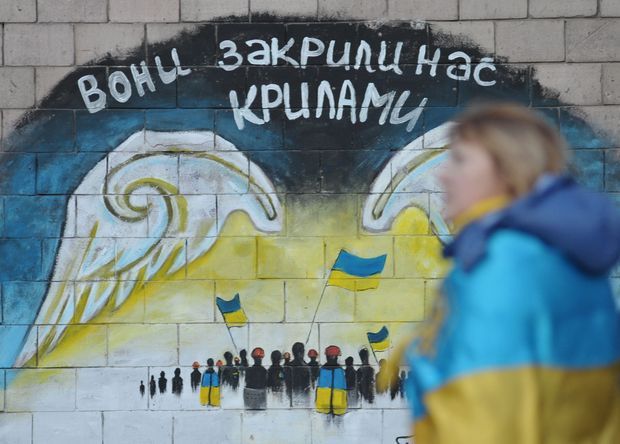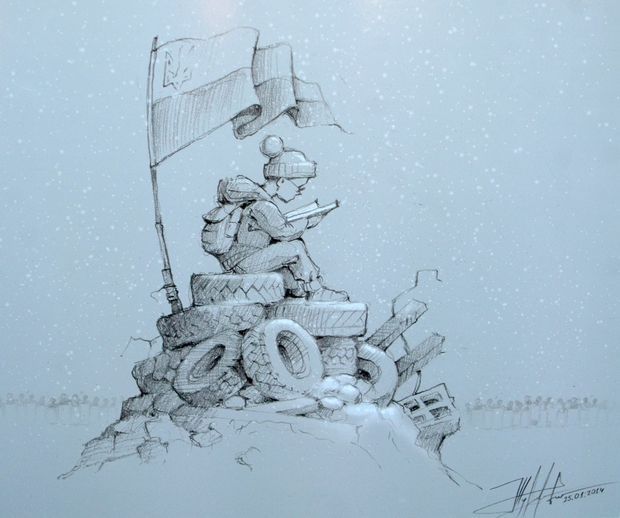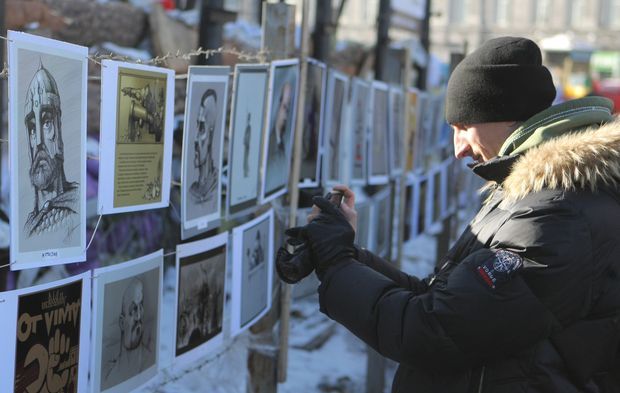We have won, because we laughed
With this article, The Day starts a series on insurgent art
The tragic events in Paris, where Islamic terrorists shot dead cartoonists and staffers of Charlie Hebdo magazine and went on to take and kill hostages, have, among other things, dramatically revived the debate about the limits to be imposed on the satirical art.
Therefore, we would like to remind our readers today of Ukrainian aspects of the story of cartoon and assault on freedom of speech. After all, we are approaching January 19, the anniversary of the day when the protest in Independence Square ceased to be controlled by compromise-prone leaders of the opposition and the revolution entered its unprecedented hot phase.
This writer deliberately photographed all recordable phenomena of revolutionary art last winter, such as posters, leaflets, works of street art, graffiti, announcements, and labels. I would like to show Euromaidan cartoons now. They mostly dealt with our and Russian political leaders, were drawn by professionals and amateurs alike and posted on walls, billboards, shop windows in downtown Kyiv as well as hung from the barricades. Many of these works were totally unique, drawn by hand and in one copy only, but most of them were reproduced by copying with a printer or a photocopier. Actual solo exhibitions were set up outdoors at the time: Yurii Zhuravel’s cartoon selection, located in European Square, attracted considerable attention, while exhibition of Oleh Smal’s sarcastic sketches, set up between European Square and Independence Square, has even acquired almost mythical status after it was completely destroyed by riot police in the evening of February 18.

Photo by the author
Cartoonists’ favorite subject was Viktor Yanukovych, of course. They did not spare bile and anger when picturing him. Most often, he was portrayed as a pig or a predator, his criminal past was often brought up, and Christmas tree, famously called “Yolka” by Yanukovych, became his real curse in these cartoons. The second most favored position was shared by Mykola Azarov, due to his innate silliness, and Vladimir Putin. They were closely followed by police (a prominent example of anti-police riposte was a cartoon depicting a child running away from police officer to a knife-wielding bandit, shouting: “Save me, sir, I saw a police officer over there!”). Less important politicians, swindlers, MPs and oligarchs, like Natalia Korolevska, Hennadii Kernes, Dmytro Tabachnyk, Viktor Medvedchuk Vadym Kolesnichenko, Mykhailo Brodsky, Serhii Tihipko, and Vadym Novynsky were featured less, but even Leonid Kuchma and Ihor Kolomoisky got their share of attention. The opposition leaders were largely untouchable, despite widespread skeptical attitude, but Zhuravel found a place for Vitali Klitschko in his cartoons. In general, more or less regular satire dominated, being sometimes very fierce, but there were absolutely surreal compositions on display in the Ukrainian House as well, where the Art Hundred was based. Artists often used ready images, like photos and pictures from TV broadcasts, which they remade into mocking collages.
As they did so, cartoon art was inadvertently acquiring interactive, collective nature. Viewers supplemented texts and images with their thoughts about subjects of ridicule, and did it quite aptly sometimes.

THE MAIDAN’S ART CHRONICLES / Photo by Artem SLIPACHUK, The Day
In general, the genre of cartoon was quantitatively inferior to more common form of cultural resistance, like posters or agitation leaflets, but it featured much more caustic approaches. After all, when Yanukovych’s mercenaries tried to retake Independence Square on February 18-20, they wanted, among other things, to suppress this laughter which their boss and the thugs themselves hated at least as much as pavement stones or Molotov cocktails thrown at them. All tyrants, those running entire countries as much as those gathering in underground gangs, are afraid of being ridiculous, because it is then that their power becomes worthless and its terror goes away. That is why they are willing to kill those who ridicule them.
The Euromaidan has won because it laughed.
More revolutionary caricatures can be accessed at our site www.day.kiev.ua. In addition, with this selection, The Day begins a series of online publications dedicated to insurgent art. Paintings and sculptures, posters and installations, graffiti and Christmas nativity scenes – they represent an entire continent of visual culture, which awaits its explorers, and we offer you to take a trip across it. Follow our updates!






